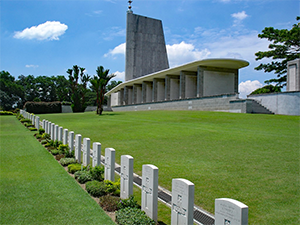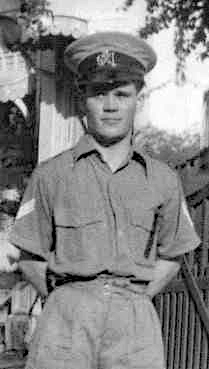Second World War - Lynsted Memorial Project
Kenneth Whigham STEVENS (of Newnham)
b. 31st January 1920 Sergeant, Service Number 876797 |

 Kenneth was born on 31 January 1920 in India. He was one of the six children of John William (born in Argentina, later resident in India), a retired locomotive engineer for North West Indian Railways, and Dorothy Charlotte Maud Margaret (née Whigham, born in India,) Stevens of 91 The Street, Newnham, Kent.
Kenneth was born on 31 January 1920 in India. He was one of the six children of John William (born in Argentina, later resident in India), a retired locomotive engineer for North West Indian Railways, and Dorothy Charlotte Maud Margaret (née Whigham, born in India,) Stevens of 91 The Street, Newnham, Kent.
At or around the outbreak of WW2, Kenneth, a Sergeant/Catering Assistant, was serving in the Indian Corps of Clerks, part of the new III (Indian) Corps. This was formed by the Indian Army during World War II for service in Southeast Asia. Unfortunately while serving in Singapore, Kenneth was captured on 15 February 1942 when Singapore fell to the Imperial Japanese Army.
Along with thousands of others, Kenneth was placed in the Malai 1 Prisoner of War Camp (known to us as Changi Camp). This camp was established after Singapore's fall and was the main camp for around 50,000 captured British and Commonwealth forces. Changi was one of the comparatively less brutal of the Japanese camps, but from here the prisoners were sent to various projects on Sumatra, Burma, Thailand and other Japanese occupied territories.
On 4 November 1942, Kenneth was entrained for the long train journey to Thailand No 2 Prisoner of War Camp at Chongkai. [See note right] Here he would have been sent to work on the infamous Burma to Thailand Railway.
After 18 months and on the completion of the railway in about June 1944, he returned to Singapore in a train consisting of steel trucks. On arrival he was housed in a Transit Camp for around 2 weeks.
Along with around 1,000 British and 200 Dutch prisoners of war, he was marched to Singapore Harbour. Once there they boarded one of the Japanese "Hell Ships" [see note right] named the Hofuka Maru. They set sail in convoy of six ships for Korea via Borneo and Manilla. The only ship in the convoy transporting POWs, the Japanese refused to have the marking displaying the fact they were carrying POWs.
Conditions on board the Hofuka Maru were horrendous [see note right] and worsened for the POWs when it had to remain in port at Manilla for one month for repairs. Many POWs died during this time.
Now repaired, on 20 September, it joined another convoy, again not displaying the sign to say that it was a POW carrier, they departed Manila and anchored in Subic Bay for the night. The following morning at 10.32am on 21 September, in the Bataan Bay, approximately 80 nautical miles north of Corregidor Island, the convoy was attacked by 100 carrier-based planes of the 2nd wave of the US Task Force 38. All the ships in the convoy were sunk. The Hofuku Maru was struck by three torpedoes and sank in about three minutes. Around 200 POWs swam to the shore, or were rescued by other ships.
Kenneth did not survive and was possibly one of the hundreds of men locked in the ship's holds with no chance of escape.
After the war, on 25 March 1947, Sergeant Major Jotani Kitaichi, the draft commander of the POWs appeared in court on the following charge:
"COMMITTING A WAR CRIME in that he on board the s.s. HOFUKU MARU on a voyage between Singapore and Japan, between the 4th July 1944 and the 21st September 1944, when in charge of a draft of British and Dutch Prisoners of War, was in violation of the laws and usages of war, concerned in the ill treatment of the said P.O.W., resulting in the death of about ninety eight of them and in physical sufferings to many others."
He was tried by Military Court at Changi on 25 March 1947. On 31 March 1947 he was found guilty and sentenced to death by hanging. He was executed on 27 May 1947. [See note below]
The Society is indebted to Kenneth's nephew, Christopher Goodever-Ballard for permission to use the portrait photograph.
If you are interest in Kenneth's story in particular, or the story of POWs in general, the Society has available to view:
Singapore to the Burma Railway as requested by, but not acted upon, by the Military Police of the Imperial Japanese Army.
|

